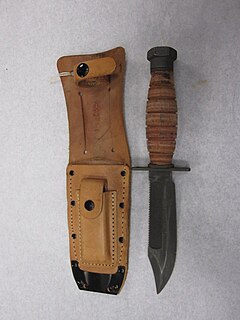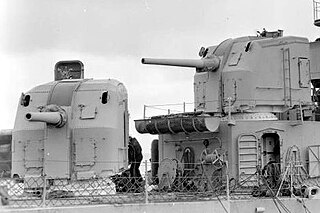| Look up bayonet in Wiktionary, the free dictionary. |
A bayonet is a blade fastened to the end of a gun or rifle.
Contents
Bayonet may also refer to:
| Look up bayonet in Wiktionary, the free dictionary. |
A bayonet is a blade fastened to the end of a gun or rifle.
Bayonet may also refer to:
| This disambiguation page lists articles associated with the title Bayonet. If an internal link led you here, you may wish to change the link to point directly to the intended article. |

A bayonet is a knife, dagger, sword, or spike-shaped weapon designed to fit on the end of the muzzle of a rifle, musket or similar firearm, allowing it to be used as a spear. From the 17th century to World War I, it was considered a primary weapon for infantry attacks. Today, it is considered an ancillary weapon or a weapon of last resort.

The M1 carbine is a lightweight semi-automatic carbine that was a standard firearm for the U.S. military during World War II, the Korean War and well into the Vietnam War. The M1 carbine was produced in several variants and was widely used by not only the U.S. military, but by paramilitary and police forces around the world. It has also been a popular civilian firearm.

A charge is an offensive maneuver in battle in which combatants advance towards their enemy at their best speed in an attempt to engage in a decisive close combat. The charge is the dominant shock attack and has been the key tactic and decisive moment of many battles throughout history. Modern charges usually involve small groups of fireteams equipped with weapons with a high rate of fire and striking against individual defensive positions, instead of large groups of combatants charging another group or a fortified line.

The Sterling submachine gun is a British submachine gun. It was tested with the British Army in 1944–1945 as a replacement for the Sten but it did not start to replace it until 1953. A successful and reliable design, it remained as standard issue with the British Army until 1994, when it was phased out as the L85A1 assault rifle was phased in.

The 1887 Constitution of the Hawaiian Kingdom was a legal document prepared by anti-monarchists to strip the Hawaiian monarchy of much of its authority, initiating a transfer of power to American, European and native Hawaiian elites. It became known as the Bayonet Constitution for the use of intimidation by the armed militia which forced King Kalākaua to sign it or be deposed.

The Type 96 light machine gun was a light machine gun used by the Imperial Japanese Army in the interwar period and in World War II.. It was first introduced in 1936, and fires the 6.5x50mm Arisaka from 30-round top-mounted magazines. A combination of unimpressive ballistic performance and a lack of reliability caused the Imperial Japanese Army to try and replace the Type 96 with the Type 99 Light Machine Gun, though both saw major usage until the end of the war.

Survival knives are knives intended for survival purposes in a wilderness environment, often in an emergency when the user has lost most of his/her main equipment. Most military aviation units issue some kind of survival knife to their pilots in case their aircraft are shot down behind enemy lines and the crew needs tools to facilitate their survival, escape, and rescue. Survival knives can be used for trapping, skinning, wood cutting, wood carving, and other uses. Hunters, hikers, and outdoor sport enthusiasts use survival knives. Some survival knives are heavy-bladed and thick. Other survival knives are lightweight or fold in order to save weight and bulk as part of a larger survival kit. Their functions often include serving as a hunting knife. Features, such as hollow handles, that could be used as storage space for matches or similar small items, began gaining popularity in the 1980s. Custom or semi-custom makers such as Americans Jimmy Lile, Bo Randall, and Chris Reeve are often credited with inventing those features.

The Type 95 Automatic Rifle or QBZ-95 is a bullpup assault rifle designed and manufactured by Norinco, and issued since 1995 as the service rifle for the People's Liberation Army, People's Armed Police and various paramilitary law enforcement agencies in the People's Republic of China. The rifle's designation "QBZ" stands for "light weapon - rifle (Bùqiāng) - automatic (Zìdòng)", in keeping with the coding standards of the Chinese defense industry.

The Karabinek wz.29 was a Polish bolt-action short rifle based on the German Kar98AZ. Identifying attributes include a 98/05 style mast bayonet lug ending directly beneath the front sight and winged protective ears to either side of the front sight blade. Cavalry models featured a turned-down bolt handle, and early versions had a stacking hook near the end of the stock on the right side.

The HK33 is a 5.56mm assault rifle developed in the 1960s by West German armament manufacturer Heckler & Koch GmbH (H&K), primarily for export.
The Fayetteville Rifle was a 2 banded rifled musket of rifle length produced at the Confederate States Arsenal in Fayetteville, North Carolina. The machinery which produced these weapons was primarily that captured at the United States Arsenal at Harpers Ferry, Virginia, which was previously used to produce the US Model 1855 Rifle.

The Mark 12 5"/38 caliber gun was a United States naval gun. The gun was installed into Single Purpose and Dual Purpose mounts used primarily by the US Navy. On these 5" mounts, Single Purpose (SP) means that the mount is limited to 35° elevation with no provision for AA shell fuze setters, and is designed to fire at surface targets only. Dual Purpose (DP) means that it is designed to be effective against both surface and aircraft targets because it can elevate to 85° and has on mount AA shell fuze setters. The 38 caliber barrel was a mid-length compromise between the previous United States standard 5"/51 low-angle gun and 5"/25 anti-aircraft gun. United States naval gun terminology indicates the gun fired a projectile 5 inches (127 mm) in diameter, and the barrel was 38 calibers long, making the 5"/38 dual purpose midway in barrel length between the 5"/51 surface-to-surface and the 5"/25 anti-aircraft guns. The increased barrel length provided greatly improved performance in both anti-aircraft and anti-surface roles compared to the 5"/25 gun. However, except for the barrel length and the use of semi-fixed ammunition, the 5"/38 gun was derived from the 5"/25 gun. Both weapons had power ramming, which enabled rapid fire at high angles against aircraft. The 5"/38 entered service on USS Farragut, commissioned in 1934. The base ring mount, which improved the effective rate of fire, entered service on USS Gridley, commissioned in 1937.
The SG 550 is an assault rifle manufactured by Swiss Arms AG in Switzerland. "SG" is an abbreviation for Sturmgewehr. The rifle is based on the earlier 5.56×45mm NATO SIG SG 540.
Operation Bayonet may refer to:
A darknet market is a commercial website on the web that operates via darknets such as Tor or I2P. They function primarily as black markets, selling or brokering transactions involving drugs, cyber-arms, weapons, counterfeit currency, stolen credit card details, forged documents, unlicensed pharmaceuticals, steroids, and other illicit goods as well as the sale of legal products. In December 2014, a study by Gareth Owen from the University of Portsmouth suggested the second most popular sites on Tor were darknet markets.
Grams is a discontinued search engine for Tor based darknet markets launched in April 2014, and closed in December 2017. The service allowed users to search multiple darknet markets for products like drugs and guns from a simple search interface, and also provided the capability for its users to hide their transactions through its bitcoin tumbler Helix.
Hansa was an online darknet market which operated on a hidden service of the Tor network.
Operation Bayonet was a multinational law enforcement operation culminating in 2017 targeting the AlphaBay and Hansa darknet markets. Many other darknet markets were also shut down.

Dream Market was an online darknet market founded in late 2013. Dream Market operated on a hidden service of the Tor network, allowing online users to browse anonymously and securely while avoiding potential monitoring of traffic. The marketplace sold a variety of content, including drugs, stolen data, and counterfeit consumer goods, all using cryptocurrency. Dream provided an escrow service, with disputes handled by staff. The market also had accompanying forums, hosted on a different URL, where buyers, vendors, and other members of the community could interact.